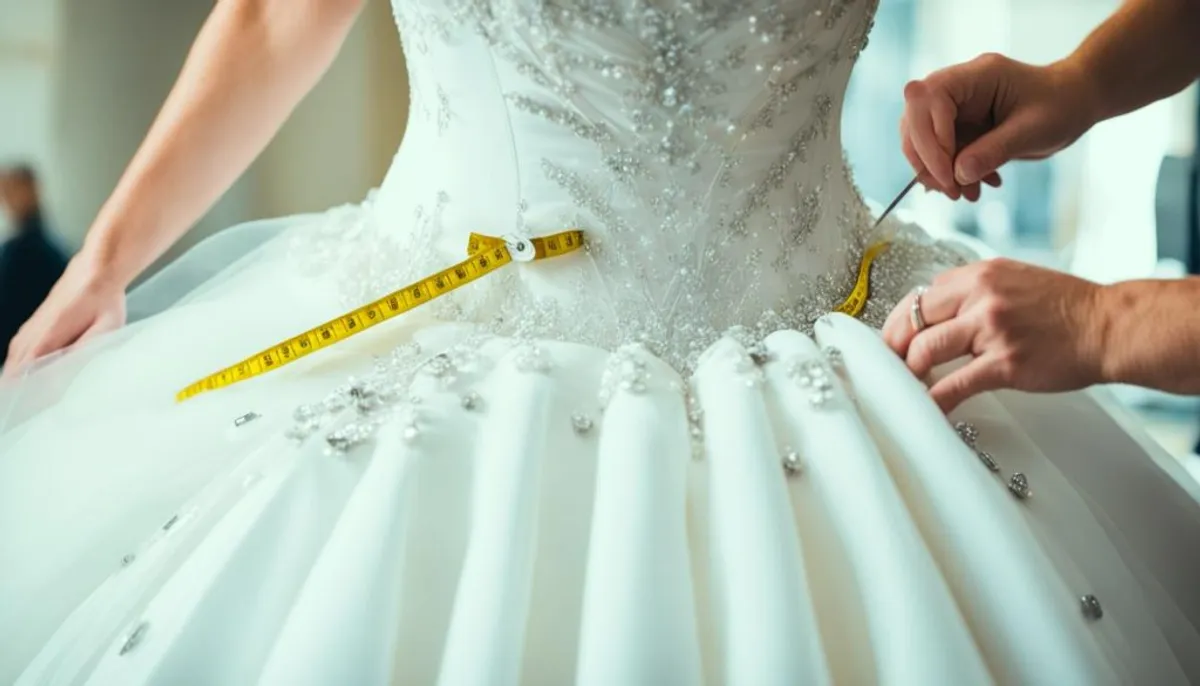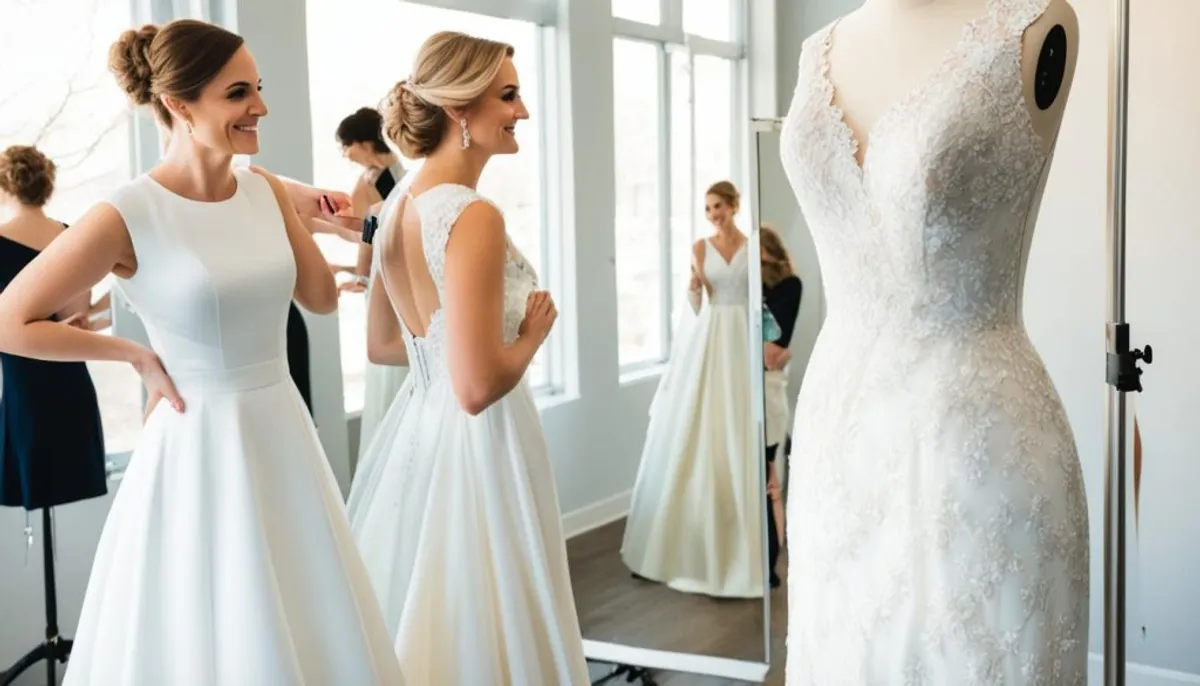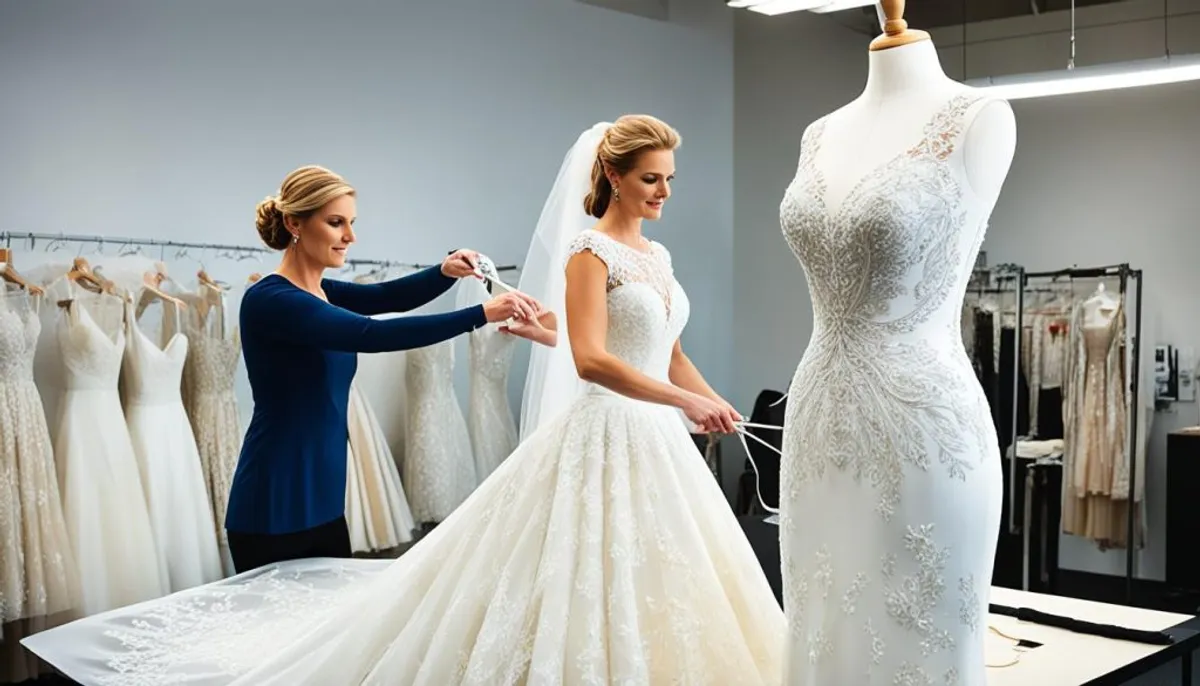The perfect fit of the wedding dress is key on the biggest day of a bride’s life. Skilled seamstresses can make even an ill-fitting dress fit perfectly. They can adjust the bust, waistline, and hemline for a great look and feel.

This guide will cover wedding dress alterations in detail. We’ll talk about why professional tailoring matters, the types of changes you can make, and tips for a smooth alteration process. If you’ve lost or gained weight, or just want a better fit, this article will help you get your dream dress.
The Importance of Wedding Dress Alterations
Tailoring your wedding dress is key to a perfect fit and boosting your confidence on your big day. Fashion expert Cindy Conroy says, “Tailoring your wedding dress is what makes you feel confident. It fits your body perfectly, giving you a stunning look.”
Expert Insights on Tailoring Your Gown
Wedding fashion expert Terry Hall notes, “Even if you spend a lot on a dress, it won’t look great if it’s not tailored right. It’s like a cheap gown looks better than an expensive one that wasn’t altered.” Tina Zimmerman, from Kleinfeld Bridal, agrees, “Every wedding dress needs alterations. They make sure the dress fits you well, meets your needs, and makes you feel beautiful.”
Professional wedding dress tailoring brings out the best in your gown. It turns an ordinary gown into a custom piece that highlights your unique style, including the popular bohemian bridal style. The importance of wedding dress tailoring is huge, from custom fit to bridal gown customization.
What to Expect During the Alteration Process
The wedding dress alteration process is key to making sure your gown fits just right on your big day. It usually includes two to three bridal fitting appointments. Each appointment is important in making your dress fit you perfectly.
At the first fitting, the seamstress will check the dress and figure out what changes are needed. This first session, lasting about an hour, marks the start of shaping your dress. As Nicole Sacco, a former expert at Kleinfeld Bridal, notes, “The gown begins to take shape when the fitter pins and tucks the fabric, molding it to your body.”
The second fitting lets you see the dress’s progress and how it will look on you. Tina Zimmerman suggests planning for three fittings. The last one is for any final tweaks to make sure the dress is spot-on. Remember to bring your wedding day shoes and undergarments to these alteration appointments.
The timeline for wedding dress alterations can differ, but starting two to three months before the wedding is wise. This gives the seamstress enough time to work their magic. Your gown will then perfectly reflect your style and vision.
| Fitting | Duration | Purpose |
|---|---|---|
| First Fitting | Around 1 hour | Assess the dress and determine necessary changes |
| Second Fitting | Varies | See the progress and get a better idea of the final fit |
| Final Fitting | Varies | Make any last-minute adjustments to ensure a perfect fit |
Common Wedding Dress Alterations
Altering a wedding dress is key to getting a perfect fit for the bride. Hemming the wedding dress is often the first step. Rita Ertl, who used to work with Monique Lhuillier, says the hem should just touch the ground. This makes sure the bride can move easily down the aisle.
Brides might also need their dress taken in or let out if their size has changed. This ensures the dress fits well and looks great.
Customizing the Dress
There are also customizations like adding straps, sleeves, or a train. Beading, bustles, and buttons are also popular. These changes let the bride make the dress her own and show off her style. For those seeking unique ideas, wedding dress inspiration can be found in various bridal magazines and online resources.
| Common Wedding Dress Alterations | Description |
|---|---|
| Hemming | Adjusting the length of the dress to ensure a perfect fit |
| Taking In or Let Out | Tailoring the dress to the bride’s body shape and size |
| Customization | Adding personal touches like straps, sleeves, trains, lace, and more |
Tips for Successful Wedding Dress Alterations
Getting your wedding dress altered can feel overwhelming, but with some expert advice, it can be smooth sailing. It’s smart to buy the dress at least 10 months before the wedding. Then, plan your first fitting 8-12 weeks before the wedding. This gives enough time for any changes or custom work.
When you go for fittings, don’t forget to bring your wedding day shoes and undergarments. This helps the seamstress get the dress fitting perfectly with your full outfit. Having a supportive friend or family member with you can also make the experience better and more fun.
Finding the right seamstress is crucial for great wedding dress alterations. Look for someone with lots of wedding dress alteration experience and an eye for details. Reading reviews from past customers can give you a good idea of their skills and service. If you're also looking for bespoke wedding jewelry brussels, consider visiting local jewelers who specialize in custom pieces.
| Wedding Dress Alteration Timeline | Recommended Timeline |
|---|---|
| Purchase Dress | 10 months before the wedding |
| First Fitting | 8-12 weeks before the wedding |
| Final Fitting | No later than 2 weeks before the wedding |
By using these tips and getting ready for the wedding dress alteration process, brides can have a smooth and fun experience. This way, they’ll feel confident and beautiful on their big day.

Can Wedding Dresses Be Let Out?
Many brides wonder if their wedding dress can be made bigger if their size changes. The good news is, most wedding dresses have extra room to expand by a few inches. But, there are things to think about.
The way the dress is made is key. If the seams were cut or notched during making, it might be hard to make the dress bigger. Also, if the dress has lots of beading, lace, or appliques, these might not be in the extra room areas. This means more work to add or fix these details.
For letting out a wedding dress, talking to a skilled seamstress who works on bridal clothes is a must. They can look at the dress and tell you how much it can be made bigger or changed. They’ll guide you on the best steps to take.
But remember, not all dresses can be made much bigger. Big size changes might mean adding panels or even replacing parts of the dress. If you're looking for a unique touch, consider incorporating ethical gemstone rings into your wedding attire. Working with a talented seamstress is the best way to get great results.
In short, if you want to make your wedding dress bigger, it depends on its design and how it was made. Many dresses can be expanded a bit, but always talk to a pro to see what’s best for your dress and your needs.
Resizing Options for Weight Fluctuations
Changing a bride’s weight before the wedding is a big part of dress alterations. Whether it’s weight loss or gain, skilled seamstresses have ways to make the dress fit perfectly. They can adjust the dress to match the bride’s new size.
Altering the Bridal Gown for Weight Loss
If a bride loses weight after getting her dress, the dress can be made smaller at each fitting. According to Nicole Sacco, “If a bride loses weight, the gown will be taken in at each fitting appointment until it fits perfectly.” This way, the dress will look great and make the bride feel confident.
Modifying the Dress for Weight Gain
For weight gain, seamstresses can expand the dress by opening seams and adding fabric. “If a bride gains weight, we will try to open the seams and release some extra fabric,” says Sacco. If there’s not enough fabric, they can order more from the designer and add a panel.
Getting wedding dress alterations for body changes right is key. It makes sure the bride feels good and looks great, whether she’s had resizing wedding dress for weight changes or altering bridal gown for weight loss.

Finding the Right Seamstress
Choosing the right seamstress for your wedding dress is key. It’s important to find someone who knows a lot about making wedding gowns. Experts say, “Letting out a wedding dress should be done by a pro, not just someone who sews a bit!” The best wedding dress alteration expert knows a lot about fabrics, shapes, and sewing techniques. They keep your dream dress looking perfect.
Here’s what to look for in a seamstress:
- They should have lots of experience with bridal and wedding dress alterations.
- They should have a portfolio with examples of their work on similar dresses and fabrics.
- They should have good reviews and be recommended by past clients.
- They should be great at talking to you to understand what you want.
- They should have a studio with all the tools and equipment needed.
By taking your time to find the right seamstress, you’ll know your wedding dress will fit you perfectly. You’ll feel confident and beautiful on your big day.
Conclusion
Wedding dress alterations are key to making brides feel confident and comfortable on their big day. Experienced seamstresses can make the dress fit perfectly, adjusting it with techniques like hemming and taking in. It’s important to work with pros to keep the dress looking great.
Following the advice in this article, brides in Saudi Arabia can easily go through the alteration process. They’ll feel their best on their wedding day. The article gives a clear guide for a smooth alteration experience.
At the end, it’s clear how important altering the wedding dress is. With the right help from skilled seamstresses, brides can have a dress that fits just right. This lets them enjoy their special day without worry.
RelatedRelated articles



